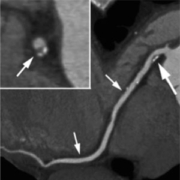Highlights from RSNA 2011
Heart attack risk differs between men and women
Coronary artery disease (CAD) is the leading cause of death for both men and women in the U.S. Researchers at the Medical University of South Carolina analysed the results of coronary CTA on 480 patients, mean age 55, with acute chest pain. Approximately 65 percent of the patients were women, and 35 percent were men. The possibility of acute coronary syndrome was ruled out for each of the patients. Using coronary CTA, the researchers were able to determine the number of vessel segments with plaque, the severity of the blockage and the composition of the plaque. By comparing the coronary CTA results with outcome data over a 12.8-month follow-up period, the researchers were able to correlate the extent, severity and type of plaque build-up with the occurrence of major adverse cardiac events, such as a heart attack or coronary bypass surgery. The statistical analysis tested all plaques combined (calcified, non-calcified and mixed) and each individual plaque type separately. Within the follow-up period, 70 of the patients experienced major adverse cardiac events, such as death, heart attack, unstable angina or revascularisation. In total, 87 major adverse cardiac events occurred among the patients during the follow-up period. When the outcome data were correlated with the CTA combined plaque findings, the results indicated that women with a large amount of plaque build-up and extensive atherosclerosis are at significantly greater cardiovascular risk than men. Specifically, the risk for major adverse cardiac events was significantly higher in women than in men when extensive plaque of any kind was present or when more than four artery segments were narrowed. However, when analysing risk factors associated with the presence of individual types of plaque, the risk for major adverse cardiac events was greater in men, compared to women, when their artery segments contained non-calcified plaque. The researchers say that new data suggest that the atherosclerotic process, or hardening of the arteries, is not necessarily linear and that more research is needed to better understand the disease. The study confirms that coronary CTA provides excellent prognostic information that helps identify risk, but there are gender differences that need to be considered.
New study supports mammography screening from age 40
Women in their 40s with no family history of breast cancer are just as likely to develop invasive breast cancer as are women with a family history of the disease, according to a study presented at RSNA. These findings indicate that women in this age group would benefit from annual screening mammography. The breast cancer screening guidelines issued by the U.S. Preventive Services Task Force in November 2009 sparked a controversy among US physicians, patient advocacy groups and the media. Much of the debate centred on the recommendation against routine annual mammography screening for women in their 40s. For the study, radiologist and managing partner Dr Destounis and colleagues from the Elizabeth Wende Breast Care, LLC, in Rochester, N.Y. performed a retrospective review to identify the number and type of cancers diagnosed among women between the ages of 40 and 49


